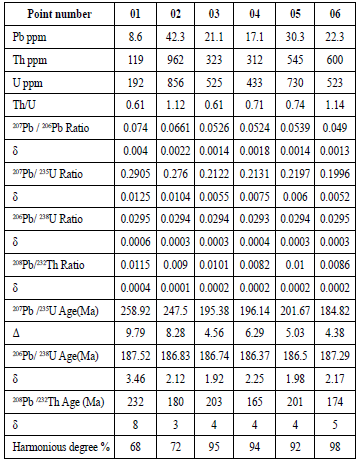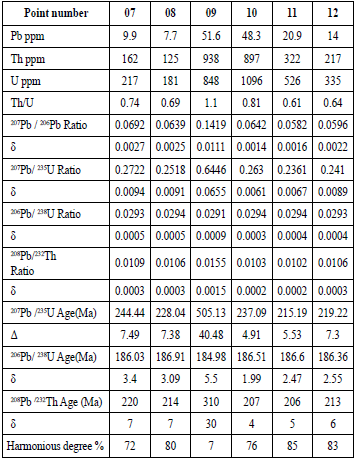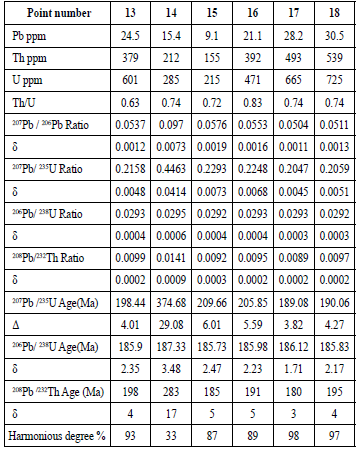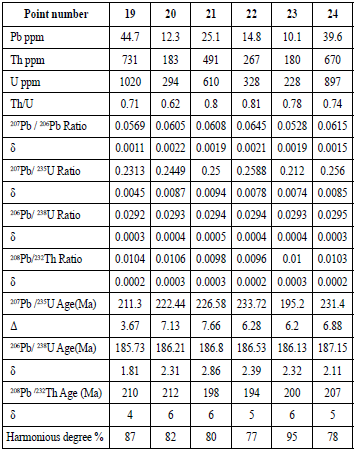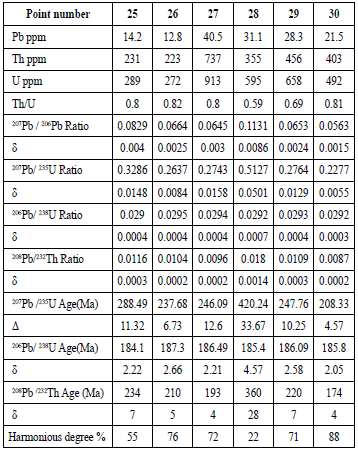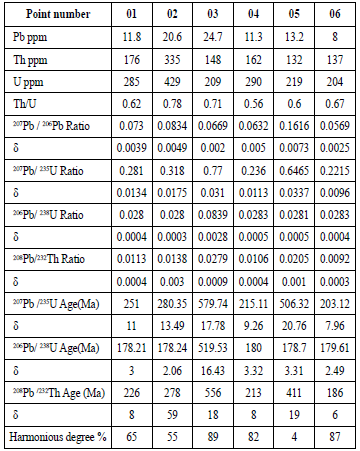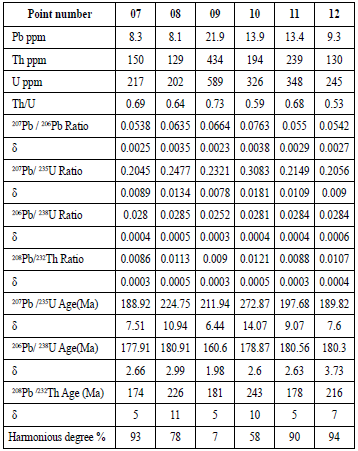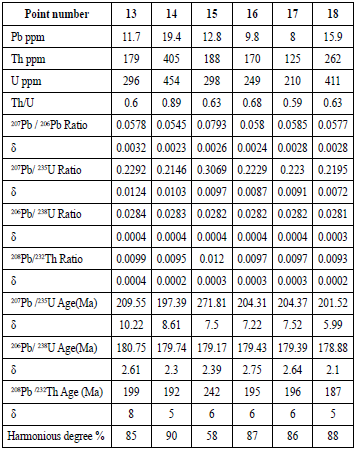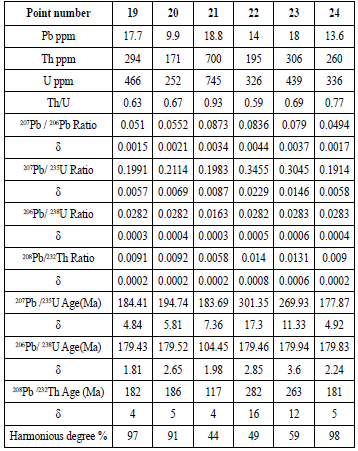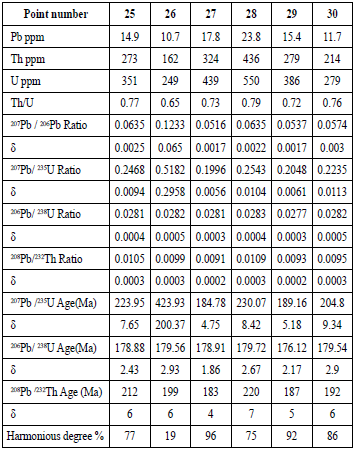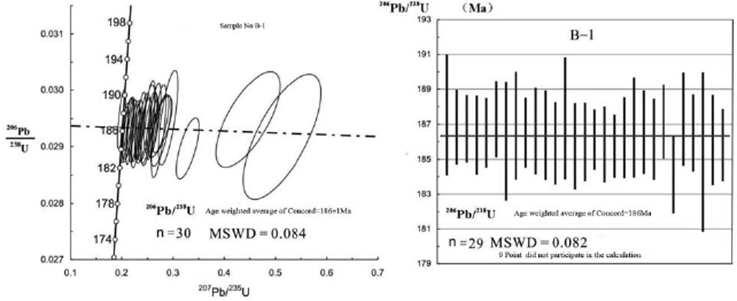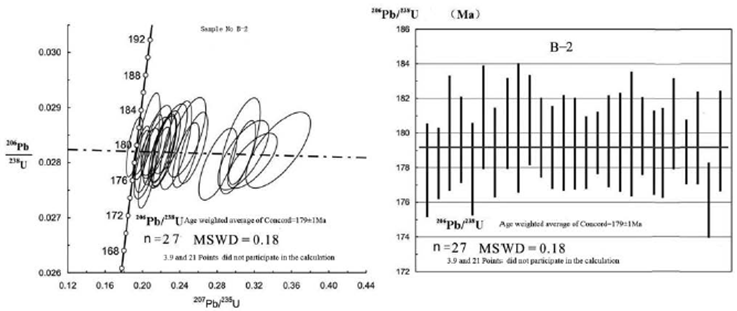Introduction
The Renzi Basin is located at the intersection of the eastern end of the east-west Nanling polymetallic metallogenic belt and the northwestern Wuyi polymetallic metallogenic belt (Fig. 1-b). The caprock is mainly composed of the Late Cretaceous Yetang Formation volcanic rocks, followed by the Paleogene Paleocene and Eocene sedimentary rocks. The formation is relatively flat, forming an open syncline basin. According to a large number of field geological surveys and borehole control, the basement of the basin is mainly composed of Cambrian, Devonian-Carboniferous metamorphic rocks and Wenxiang granite, namely "double base". The cap layer is not integrated on the basement, forming a pattern of the upper collapsed basin and the red basin of the brazier. At present, many uranium, molybdenum, lead, zinc, gold, silver and rare earth polymetallic deposits and mineralization have been found in Renchao fault basin (Liu et al., 2007; Xu et al., 2010).
According to dating data, the cover volcanic rocks in Rencha basin were mainly formed at 90 Main Late Cretaceous. The Dashenba rock mass (135 Ma) of Early Cretaceous, Guikeng granite of Indosinian-Yanshanian period and eight-foot gneissic granite (165 +1 Ma) were widely exposed on both sides of the basin (Liu, et al., 2007). So far, no plutonic rocks corresponding to the caprock volcanic series have been found in the basin. In addition, the cover of the basin is thick and the granite is less exposed. At present, the granites exposed by the borehole are mainly composed of fine-grained zeolitic granites, which are in contact with the overlying Paleozoic strata. At present, the igneous rocks of these basements have been lacking in precise dating. The formation of the LA-ICP-MS zircon U-Pb age was studied by geological exploration of the bored area of the Rencha Basin.
Survey of Research Areas
Renchao Basin is located in the Caledonian fold system of South China, the Late Paleozoic depression belt of Yongan-Meizhou, and the northeastern part of the Heyuan deep fault zone. It belongs to Pingyuan County, Meizhou City, Guangdong Province. It is about 15 km in length from north to south, 10-15 km in width from east to west, and has an area of about 200 km 2m2. The basin is a typical volcanic faulted basin, which consists of a set of rhyolitic and acidic rock-dominated complex formations. The lower part of the strata is breccia tuff and rhyolite, the middle part is pyroclastic rock and lava tuff, and the upper part is pyroclastic rock (Song et al., 2010). The basin is NNE-trending and belongs to Mesozoic-Cenozoic continental volcanic faulted basin (K2-E). The basement of the basin is composed of Cambrian, Devonian-Carboniferous epimetamorphic rocks and early Yanshanian Wenxiang granites, which mainly distribute in the margin and outside of the basin. The caprock is mainly composed of Cretaceous volcanic rocks, followed by Late Cretaceous-Tertiary volcanic-clastic sedimentary rocks. The basin structure is dominated by faults, mainly NNE, followed by EW and NWW. The NNE on the west side of the basin to the Zhegulong fault and the east side NNE to the Zhumaba basin is the basin control structure, and the near EW to Malou fault constitutes the southern boundary of the basin. Several NNE-NE-trending secondary faults are also developed in the central part of the basin. In addition, the NWW-trending structures developed in the basin are filled with medium-basic dikes. The granite is mainly distributed in the east and west sides and the margin of the basin. The east side is the early Dashenba rock mass in the Yanshan Mountains, and the west side is the Indosin Yanshan period Guikeng rock mass. The lithology is medium-grained porphyritic biotite granite. In the western part of the basin, there are also medium-fine-grained mica granites and fine-grained biotite granites. In the south, there are sub-flow porphyries with narrow strips and other outputs (Li et al., 1998).
Samples and analytical methods
In this work, samples of granite cores from ZK1702 (760 m) and ZK1401 (610 m) drilling holes in Chagan area, northern Renchao Basin are collected and zircons are separated for LA-ICP-MS zircon U-Pb dating. The sample number collected in ZK1702 is B-1 (north latitude 24°53'07"; east longitude 115°57'33''), and the sample number in ZK1401 is B-2 (north latitude 24°53'26''; east longitude 115°57' 07''). The core of the collected sample is preserved intact, and the rock is fresh and not weathered. The rock hand specimen is fine grained granitic granite (Fig. 2-a~b). The sample is patchy, the matrix is microscopic, and the image symbiote is between 0.05 mm and 0.15 mm. There is a local mosaic structure (Fig. 2-c~d). The size of automorphic quartz phenocrysts and potassium feldspar (diorite) phenocrysts is mostly 1-2mm, and the maximum is 5mm.
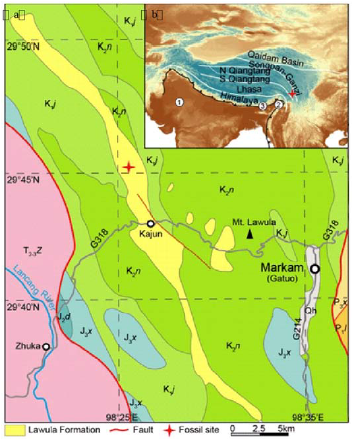
Figure 1 (a) Simplified geological map of rencha volcanic basin area (b) Tectonic location of the studying area
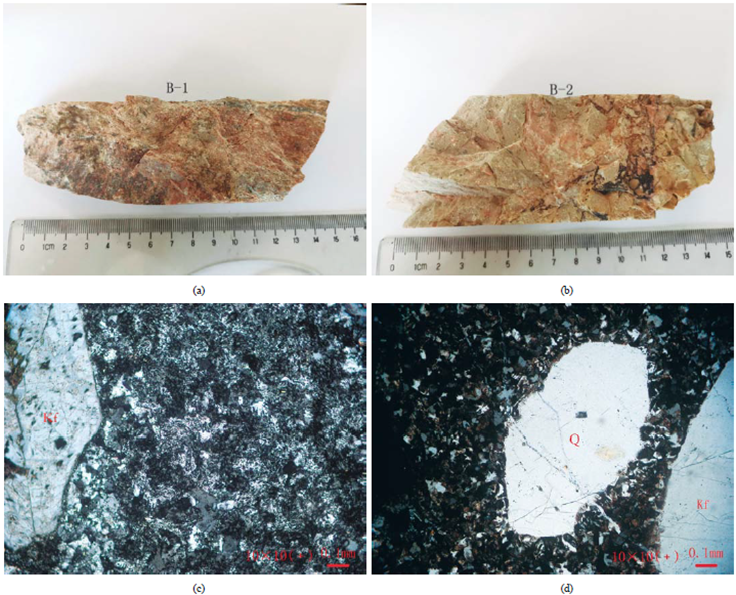
Figure 2 (A) Sample hand specimen and micrograph in Chagan area. a, b-fine grain granitic granite hand specimen; c, d-text image granite microphotograph (orthogonal polarized light)
Firstly, the core samples weighing about 1 kg are cut up and crushed, 80-100 meshes are screened, the rock powder washed out. The obtained heavy sand is electromagnetically sorted, the non-magnetic part is separated by heavy liquid, and the heavy part is taken.
Finally, zircon crystals are manually selected. The zircon crystal is made into an epoxy sample target and polished. Zircon transflective and cathodoluminescence (CL) photography is performed at the Laboratory of Geological Mineralization and Process Center of Sun Yat-Sen University. The target of zircon sample is observed by optical microscopy and scanning electron microscopy cathodoluminescence (CL). Zircon crystals with good crystal shape, no cracks and undeveloped inclusions are selected for determination (Figure 3).
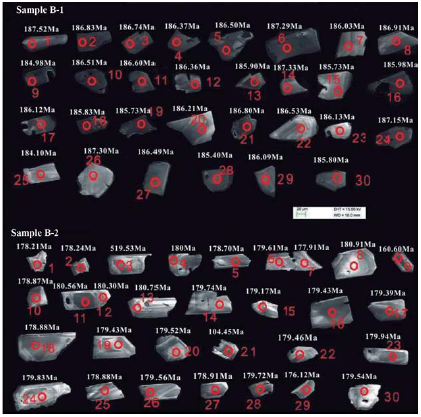
Figure 3 CL images of analyzed zircon from graphic granite (B1, B2) basement in Chagan Area (The figures in the figure represent the point number and zircon age, which correspond to tables 1 and 2)
LA-ICP-MS zircon U-Pb dating is completed online by ICP-MS and laser denudation system at the State Key Laboratory of Geological Processes and Mineral Resources, China University of Geosciences (Wuhan). ICP-MS is Agilent 7500a produced by Agilent Company in the United States, and laser denudation system is GeoLasPro produced in the United States. The laser spot size of sample melted by laser is 18μηι. ICPMSDataCal software is used for data processing (Liu et al., 2010; Liu et al., 2008; Gao et al., 2020). U-Pb isotope dating uses standard zircon 91500 as external standard for isotope fractionation and U content correction. Recommended values for U-Th-Pb isotope ratios for zircon standard 91500 according to Wiedenbeck et al. (1995). Using standard zircon Plesovice as a monitoring sample, the TIMS measured at 206 Pb / 238 U was 337.13 ± 0.37 Ma (2σ) (Slama et al., 2008). Sample U-Pb harmonic plotting and weighted average calculations are performed using Isoplot/Ex_ver3 (Ludwig, 2003). Normal Pb correction is performed using the ComPbCorr #3.18 program (Andersen, 2002). Thirty zircons are tested in two samples. A group of samples are determined for 60 seconds, in which the first 20 seconds turned off the laser and the last 40 seconds turned on the laser. Because apatite contains more common lead, if the content of La or P is higher at the analytic point, it indicates that the laser melting point contains apatite inclusions, these analytic data points should be excluded (Liang et al., 2006; Harris et al., 2004).
U-Pb dating of zircon
The results of LA-ICP-MS zircon U-Pb isotope dating parameters of fine grained Wenxiang granite in Rencha Basin are shown in Tables 1 to 10, respectively. The results of optical microscopy show that the zircon grains in the samples are small, mostly self-shaped or semi-self-shaped columnar, with good crystal shape, light yellow, light rose or colorless. The polymorphism is composed of cylindrical (110) (100) and conical (111) (131). The lengthwise direction of the zircon grains is 80-200μηι, and the aspect ratio is between 1 and 3. The Th/U ratio of zircon can indicate metamorphism or magmatic origin to some extent. The Th/U ratio of metamorphic zircon is usually less than 0.1, and that of magmatic zircon is generally greater than 0.4. Th/U ratios at all points measured are greater than 0.4, averaging 0.76 (B-1) and 0.69 (B-2), with obvious magmatic zircon characteristics. Although a small part of zircon oscillating zoning or fan-shaped zoning of fine-grained Wenxiang granite in the two samples is not obvious, considering the Th/U ratio of zircon, the zircon selected in this test has typical magmatic zircon characteristics, and the U-Pb age of the main group zircon can represent the age of magmatic crystallization.
A total of 30 data of 30 particles were obtained from sample B-1. The weighted average age of 206Pb/238U is186+1Ma (MSWD=0.084). One of the analysis points (point 9 has a harmonicity of 7%) has a low degree of harmonicity and is eliminated when recalculating the age. The remaining 28 analysis points have an age of 206Pb/238U between 184Ma and 187Ma. The weighted mean age of the remaining 29 analysis points is calculated by Isoplot software to be 186. Ma (MSWD = 0.082), which represents the crystalline age of B-1 fine grained granite (Figures 4 and 5).
A total of 2830 data are measured for sample B-2 (points 6 and 7 and points 11 and 12 belong to the same zircon). In the analysis point, the age of point 3 is 519 Ma, which may be the early magmatic zircon captured in the process of rock formation. The ages of point 9 and 21 deviate from the mode obviously. Therefore, the three analysis points do not participate in the calculation of weighted age. The weighted average value of the remaining 27 206Pb/238U ages obtained by Isoplot software is 179+1Ma (MSWD=0.18), which represents the crystallization age of fine grained granite from B-2 samples.
The above LA-ICP-MS zircon U-Pb dating data show that the MSWD values of the basement fine-grained hieroglyphic granites in Renchao Basin are small and reliable. The two diagenetic ages are 179±1 Ma and 186 Ma, respectively. The ages are late Early Jurassic. Because of the age difference between magmatism and consolidation diagenesis, the basement granite in Renchao basin should be the product of early Jurassic magmatism.
Discussion
The early Yanshanian in southeastern China is generally considered to be a critical period for the transition from the Paleo-Tethys tectonic domain to the Pacific tectonic domain (Shu & Zhou, 2002; Chen et al., 2002). Before the Middle Jurassic was affected by the Tethys tectonic domain and the Indosinian collision, the Late Jurassic has been mainly constrained by the combination of Pacific tectonic and intracontinental deep structures. However, during the transition period of the two tectonic domains (ie, the early Yanshanian), the South China provinces lacke the isotopic age values (200-180 Ma) of the Early Jurassic igneous rocks (J1). Therefore, it is generally believed that J1 is the intermittent period of magmatic activity (Yu et al., 2009). Although the geological work in southeastern China has been relatively high in the past, it mainly focuses on the late Mesozoic igneous rocks and Cenozoic volcanic rocks. The study on the geological characteristics and tectonic setting of early Mesozoic igneous rocks is not in-depth, especially the isotopic age of early Jurassic igneous rocks.
Chen et al. (2002) made Rb-Sr isochron dating of bimodal volcanic rocks in the Xunwu-Baimianshi basin and Dongkeng-Linjiang basin in southern Jiangxi Province. The values of 178±7Ma for basalts in Dongkeng basin, 173±6Ma for basalts in Baimianshi basin and 165±2Ma for rhyolite are equivalent to those of late Early Jurassic to early Middle Jurassic, which changed the predecessors'opinions on the formation of igneous rocks in these areas in late Jurassic. Xu (1992)proposed for the first time that the volcanic rocks in Fankeng Formation in Yongding, Southwest Fujian Province were bimodal assemblages of Early Jurassic (Rb-Sr age 179 Ma), formed in intracontinental extensional environment, which aroused scholars' attention to the early Jurassic igneous rocks in the southeastern continent. Zhou and Chen (2001) obtained the Rb-Sr isochron age of the rhyolite in the Yongding Hulei basin again. Li and Li (2007) have made SHRIMP zircon U-Pb dating of the Keshubei intrusion in southern Jiangxi, and obtained an isotopic age of 189±3Ma, which coincides with the age of 187±4 Ma (zircon U-Pb) measured by Ding et al. (2005) of the Xiangzikou intrusion in the middle part of Nanling Mountains, Hunan Province. Xing et al. (2002) made Rb-Sr isochron dating of gabbro in Meizhou Xialan complex, and obtained 179 Ma age. Again, SHRIMP zircon U-Pb dating of granite (1196±2Ma)) and gabbro (1195±1Ma) in the intrusion proves that magmatic activity also existed in the early Jurassic in northern Guangdong (Yu et al., 2009), which is also the earliest granite age of Yanshanian period up to now. It is believed that the Pacific tectonic domain has begun to act on South China (Chen et al., 1999) at least around 195Ma. The Yanshanian magmatic activity along the southeastern coast of China is a part of the tectonic-magmatic cycle in the western Pacific Ocean. Compared with the unprecedented magnitude and intensity of magmatic activity in the Late Jurassic (~140 Ma), the signs of early Jurassic magmatic activity are not obvious. However, the above age data indicate that the Pacific plate subducted to the Eurasian plate in the Early Mesozoic (~200Ma), which has a precise chronological record in the middle and eastern part of Nanling Mountains. The U-Pb zircon ages of the two groups of fine grained Wenxiang granite in the Renchao Basin are 179±1Ma and 186 Ma, which provide new information for the lack of reports of magmatic activity during the J1 period in southeastern China. The origin of the U-Pb zircon may be related to plate subduction, mantle material upwelling or heating of crustal material and the introduction of some mantle-derived material. Although the early Yanshanian granites are mostly the products of magmatic emplacement under extensional tectonic environment, the alkaline rock-syenite-granite assemblages formed in the typical extensional tectonic environment of the same period have not been found yet because of the intense volcanic activity in the late Yanshanian period of Renchao Basin, the thick coverage of volcanic caprock and the few outcrops on the surface. In addition, the study area is located at the junction of Nanling and Wuyi metallogenic structural belts, and its tectonic significance is particularly special (Zhao et al., 2008). Therefore, the geological work in this area needs to be further strengthened.
Conclusion
The LA-ICP-MS zircon U-Pb dating of the basal-image granite in the poor dry area of the Renzi Basin yielded the isotopic ages of 179±1Ma and 186Ma, respectively. It indicates that the formation of the basement lithology granite in the Yanshen Basin is in the late Early Jurassic period and is the product of the first magma activity of Yanshan. This age provides new chronological data for reports of the lack of magmatic rock activity during the J1 period in northeastern Guangdong. The subduction of the Pacific Plate to the Asian Plate in the Early Mesozoic (~200Ma) resulted in the warming of the crust, the melting of crustal materials into magma, and the compression of the crust resulted in a series of NE-trending sag basins. The basement hieroglyphic granites in the Renchao Basin were formed at this stage. During this period, the Dading iron ore back rock mass (176±4M a) in Lianping and Zijinshan rock mass in southwestern Fujian were (168±4Ma) (Wu & Zheng, 2004), both of which developed granite basement. Although they were formed later, they should be the product of magmatic activity in the same period regionally.













